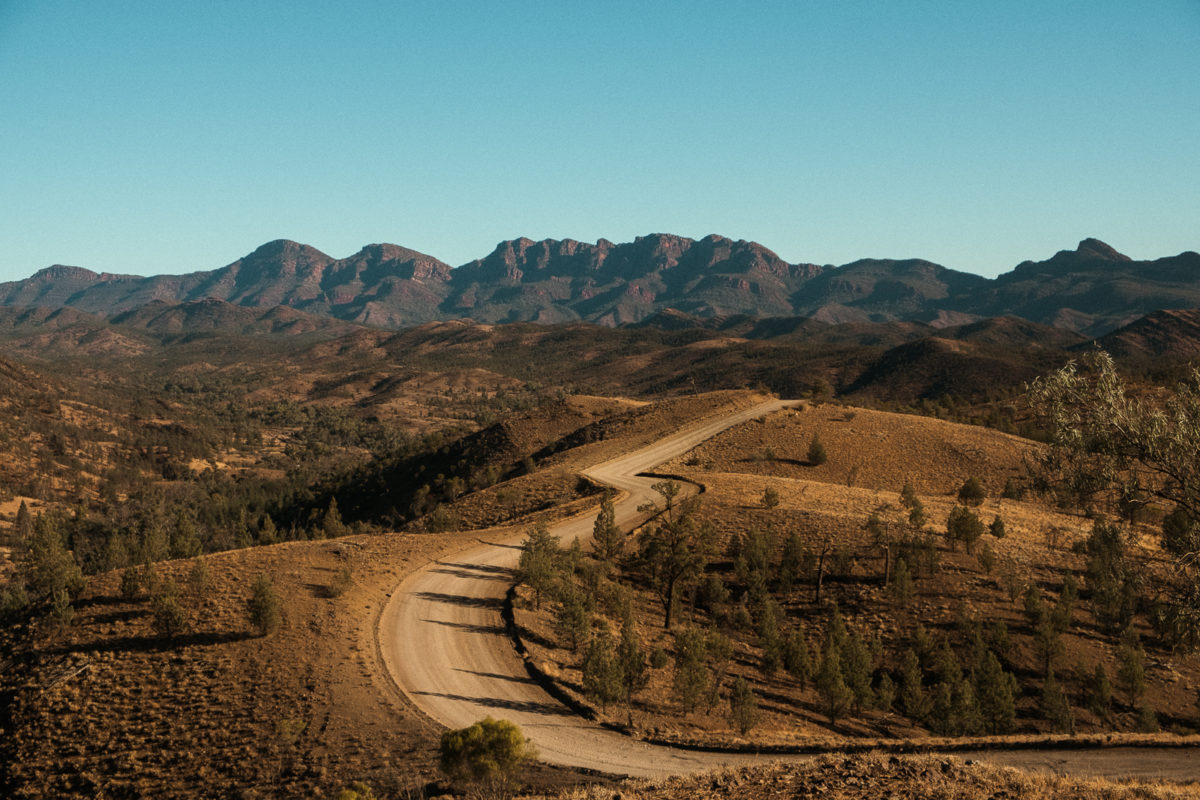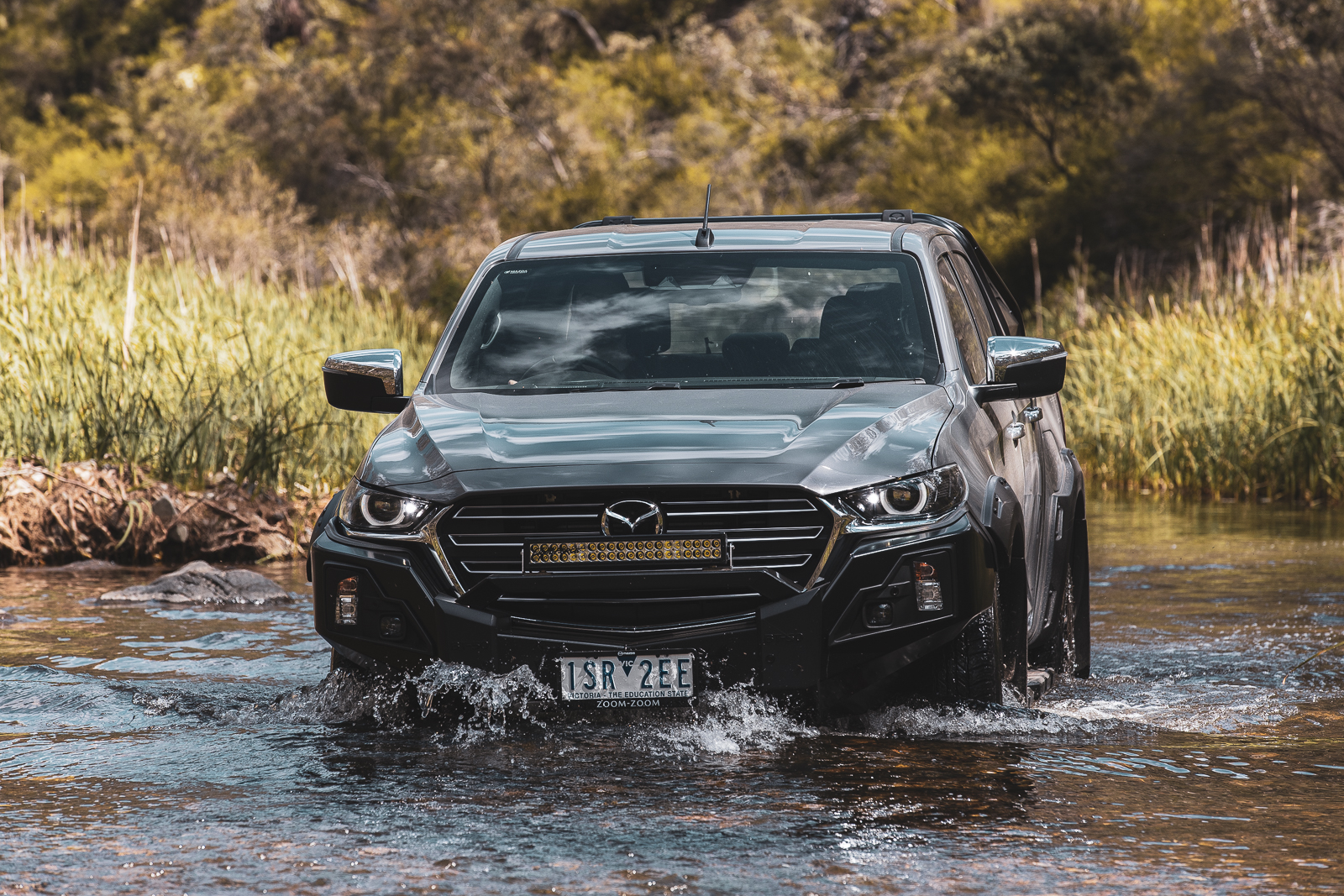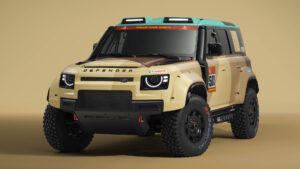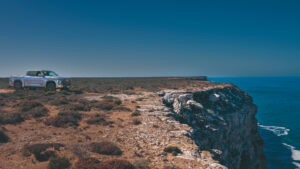The entire country has gone outdoors mad. Along the entire east coast, the beaches are packed, the local caravan parks are bursting at the seams, and you’re kidding if you think you’ll find an empty BBQ at the park for a Sunday game of cricket. If you want some serious adventure, away from the crowds, you’re going to have to engage your diff locks, and the best place to start is by learning what in good gracious diff locks even are.
Here’s our beginners guide to getting you out in the wild and livin’ big this summer with the brand-new Mazda BT-50 Thunder.

The Basics
How does a 4×4 work?
If you’ve been making goo-goo eyes at our BT-50 Thunder, you might be wondering why exactly it’s able to get further than your mate’s hatchback and his blatant disregard for mechanical sympathy.
A typical car is a 2×4. That means power is sent to two out of the four wheels. A clever device called a differential, disconnects those two wheels so you can steer without the wheels fighting against each other. In short…two wheels can have drive, but only one wheel at a time will have drive. Capeesh? The Brand-New Mazda BT-50 is a 4×4. That means in 4×4 mode, power is sent to both the front and rear axles where one of the two wheels will then receive drive. That’s a 100% increase in traction, with one wheel pushing and one pulling. Good stuff right?
The Brand-New Mazda BT-50 has a couple more tricks up its sleeve that help it get further again. A rear locker means that, off-road, the two rear wheels can be locked together so 3 out of the 4 wheels are driven. That’s a 200% increase in traction to get you through tricky terrain. It’s a winning combination. The little low-range selector is essentially putting it into an insanely low first gear meaning you’ve got bulk control, and your engine will essentially have twice the muscle.

Know where you are, but not where you’re going…
So you’ve got your 4×4, a car full of mates (all keen on an adventure), and a detailed trip itinerary going through every stop you’re making, and the approved Instagram photo stops you’ve scheduled. Your first step, as approved by us, is to throw that itinerary in the bin and put your faith in the built-in Sat Nav.
Half the fun of owning a 4×4 is the excitement of exploration, so head off to a big green area on a map and have a look around. Poke your spotlights down overgrown tracks and wind the windows down to really soak up the outdoors. If you’re really remote, it’s probably wise to have a backup GPS or emergency beacon in the glovebox, but otherwise, just follow the Sat Nav to keep tabs on where you are if you can’t remember your way back to the main trails.
Prepare to get stuck
You’re going to get stuck. It’s not a matter of if, but when. Anyone who has never been stuck off-road hasn’t given it a proper crack.
It’s not a big deal, so don’t sweat it. Just have a plan on how to get yourself out of strife before you get into it. The easiest solution is a second 4×4 with a snatch strap that you can drag each other out with if things go sideways. Failing that, a 12V winch is a great tool to have. Traction boards can be fantastic but they shouldn’t be your only tool. Hand winches will get you out, but you’ll never want to go 4x4ing again, so maybe don’t put yourself through that torture.
Don’t bite off more than you can chew
You know what feels amazing? Driving an obstacle you weren’t sure you could make. You know what doesn’t feel amazing? Destroying your 4×4 trying to drive an obstacle you weren’t sure you could make. The best off-road drivers in the world sucked the first time they did it. They learned how to be good by doing it over and over again and continually challenging themselves. You can’t unpretzel a 4×4 once you’ve cooked it, but you can come back another day with a bit more confidence or a bit more time up your sleeve and tackle that obstacle you’ve been eyeing off for months. You’ve got all the time in the world to get good.


Terrain
Mud/Wading
Mud is one of the biggest attractions newcomers to 4x4ing can possibly have. It’s hilarious. Wheels are spinning, mud is spraying, your ute is sliding around like Han Lue in the Oscar-winning action movie Fast & Furious: Tokyo Drift. It’s an absolute ball. But it’s not without its down sides. Mud is a combination of water, and abrasives like dirt and sand. After a session in the pits you’ll not only need to scrub your rig to get it clean as a whistle again, but you’ll also have to deal with the premature wear on everything from suspension bushes to cv joints. And we’re not really keen on facing a stern Mazda service department to have that conversation.
If you can’t be talked out of it, there are a few tips and tricks to keep in mind. Mud tyres are named that for a reason. The big chunky tread blocks are exactly what’s needed to get traction in the slop. Road tyres or All Terrains won’t cut it. Lowering your tyre pressures down to the 20psi mark will give you more footprint without too much risk of rolling a tyre off the rim.
As for wading, well, the all-important rule reigns true – don’t bite off more than you can chew. Stick to the designated track, scout the current and depth as best as you can before you entering, and get yourself a snorkel if you plan on seriously getting wet.
RELATED: How To Customise Your Dream Ute – The Ultimate Accessories Guide

Rocks
Driving in rocky terrain is both the most technically difficult, and visually boring thing you can possibly do in a 4×4. It’s a delicate balancing act of pushing your 4×4 to its absolute capability in terrain that’d see soft roaders turn to mush, but the better you are at it the tamer it looks like to spectators. Like most terrains, quality tyres are a must, and tyre pressures in the 16-18psi range will bag out the tyre, increasing the footprint giving you even more traction.
Line selection is key when in the rocks, especially in an IFS dual cab like our BT-50 Thunder. Look at the terrain and walk it with your hands out to your sides roughly the same width as your front tyres and visualise where your tyres will sit as you go through the obstacle. You want to keep your rig as horizontal as possible. If there’s a big hole in the track it’s better to have it directly under your 4×4 than dropping a wheel into it. From here, just look at when your wheels will be climbing the steps. Avoid having front and rear axles climbing at the same time if possible, and don’t be scared to hit that locker button.


Sand Driving
Let’s get one thing straight, sand driving is some of the most fun you can have in a 4×4. From the stunning locations you’ll do it in, to the feeling of having your ute sliding around under you at 60km/h while the waves roll against the beach just metres out your window. It simply can’t be beaten.
The first thing to know is that sand doesn’t drive the same everywhere, or even at different times of day. Soft sand will be hard on your 4×4 and can frequently require low range for the extra gearing, or high momentum which can raise issues. As a general rule, if the area was once mined, or it’s a hot day, the sand will be soft.
From here, drop your tyre pressures down. Mud or road tyres won’t change much. 12-15psi will see you home free, just don’t swing the steering wheel too aggressively as you do run the risk of rolling a tyre off the wheel. Bring a shovel, a mate with a recovery strap, and an esky for a few refreshments back at camp. This is as good as it gets.

Outback Highways
The Aussie Outback is something that has to be seen to be believed. It’s a whole ‘nother country out past the black stump and something you simply can’t appreciate unless you’ve done it yourself. The driving itself is rarely challenging, but there are a few precautions you need to have sorted before you head off.
There’s no phone service anywhere. Okay, not really, but it’s a safe assumption anyway. Carry cash in case the outback roadhouse doesn’t take card, have an itinerary planned out (share it with friends), and carry a Personal Locating Beacon or satellite phone if possible so they don’t freak out if you’re a day behind schedule.
Quality tyres are a must as well, traction won’t be much of an issue as you’ll be doing 80km/h+ on most tracks but your tyres will cop a hiding road tyres won’t cope with. Bring plenty of water as well, more than you think you’ll need. Have a few extra supplies of food stowed away in case you need it. And have ample fuel with you in case you take a detour or a town on the map you thought you could get fuel at turns out to be a sheep station abandoned 100 years prior. This is going to be one adventure you’ll remember for a lifetime.

This article is proudly presented in partnership with Mazda. Thank you for supporting the brands who support Boss Hunting.
















